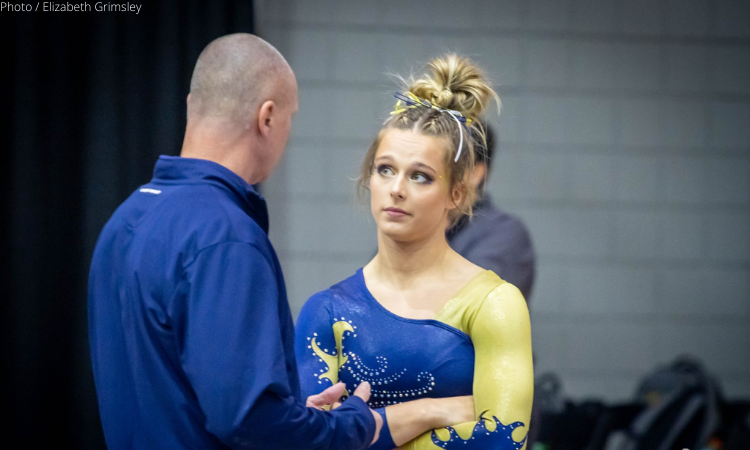Like many other college gymnastics fans, I excitedly tuned into yesterday’s selection show live to see the unveiling of the 2021 postseason bracket. However, unlike most other fans, I wasn’t looking for a particular team’s regional placement or a favorite individual’s qualification; I was hoping to see improvements in the bracket distribution compared to 2019, the first year of the current format. To say I was disappointed is an understatement: Not only are the same issues from 2019 still present—most notably the regional semifinal distribution—but this time around the selection committee made an even bigger mess of the play-in round.
To paraphrase the great Nicole Auerbach, this college gymnastics bracket makes no sense.
I’ve written about the unequal distribution within the bracket before, but I’ll sum it up again: Instead of arranging the regional semifinals in a snake-like distribution like literally every other bracketed sport in existence, the selection committee once again chose to put the first-, fourth-, seventh- and eighth-seeded teams in one semifinal, with the second-, third-, fifth- and sixth-seeded teams in the other. This is a monumentally unfair way to seed the teams as it gives the first- and fourth-seeded teams a huge advantage and basically screws over every other team in the regional. Why should the third-seeded team have to fend off both the fifth- and sixth-seeded teams to advance while the 4th-seeded team only has to beat the seventh and eighth seeds? This is inexplicable and inexcusable, at least to those of us who care about math and fairness.
Gym fans often find themselves in the unfair position of having to defend gymnastics as a “real sport” and nonsensical decisions like this do us no favors. Can you imagine the shocked outrage of fans and media alike if the NCAA Men’s Basketball Tournament decided to rearrange its bracket so that the eighth seed in a region met the fourteenth seed in the first round while the sixth seed played the tenth seed? That’s more or less what’s happening in college gymnastics, but the selection committee either doesn’t understand math or it just doesn’t care. What is the point of seeding at all if higher seeds don’t have an easier path to advancement? What incentive is there to be a team ranked fifth through 12th nationally if teams ranked 13th through 16th get an easier draw at regionals?
Moving on to the next issue: the unequal distribution of unseeded teams. There are 12 teams that are unseeded but have a bye in the first round. Per the NCAA’s own documentation, these teams are supposed to be arranged “geographically” with no mention of rank or NQS among the listed criteria. Here are the rankings of the 12 teams that were placed in each of this year’s regionals:
Athens: 18, 24, 25
Tuscaloosa: 19, 20, 23
Salt Lake City: 17, 21, 22
Morgantown: 27, 28, 29
Let’s play a game of “One of These Things Is Not Like the Other,” shall we? In the Athens, Tuscaloosa and Salt Lake City regionals, every team that ended up as the seventh-seeded team is ranked higher than the fifth-seeded team in Morgantown. Again I’d like to ask, what is the incentive for a team to improve its ranking if it won’t be rewarded for it in the postseason?
While all three of those teams in the Morgantown regional will indeed be traveling to their closest regional, I’d like to know what the higher-ranked Central Michigan thinks about having to travel to Athens when their closest regional also would’ve been Morgantown. I’d also like to know how Oregon State feels about having to travel across the country to Athens while lower-ranked teams get their geography prioritized. And how does George Washington’s Deja Chambliss feel about traveling all the way to Salt Lake City with five other vault qualifiers while only two are being sent to the much closer Athens? While it’s admirable to want to keep travel costs down, this should not be prioritized over fair play (and, let’s be honest, this “geographical” placement isn’t keeping travel costs down when you’re sending multiple teams across the country). Teams should be rewarded for a higher ranking. Period.
And now for the most shameful part of this year’s bracket: No. 26 N.C. State is in the play-in round instead of No. 29 Kent State. Because…reasons? If only we had one of those televised post-bracket reveal interviews with the head of the selection committee like they do in college football, maybe we could hear whatever outlandish explanation there is for this disgrace. The unsaid explanation is probably once again geography—because Kent State is relatively close to Morgantown—but the higher-ranked N.C. State should not be forced to compete an extra round in a tournament as a penalty for not being located close enough to a regional host. This exceeds any of the stupidity in the 2019 bracket and sets a new low bar for the selection committee.
Not only is N.C. State put at a gross disadvantage by this decision, it directly affects the individual qualifications as well. If the No. 29 to No. 36 teams had been named to the play-in round, Stanford’s Chloe Widner would have qualified as an individual in the all around, an incredible accomplishment considering her team only competed in five meets this year. Instead, her spot went to an N.C. State gymnast since play-in teams are included in the pool for individual qualifiers. Did the selection committee really not examine the potential ramifications of including a top 28 team in the play-in round? It wouldn’t surprise me given that individual qualifiers are already an afterthought in this postseason format: It’s already unfortunate that gymnasts on play-in teams are eligible to take the already limited individual regionals spots from gymnasts on non-regionals qualifying teams, but then the number of individuals that qualify to nationals from each regional is even smaller. But that’s a topic for another day.
The selection committee needs to accept that it is impossible to prioritize geography without undermining the integrity of the postseason competition. There will always be teams who have to travel a long distance in the postseason no matter how the bracket is arranged. However, there is a way to balance geography and fairness.
I propose that women’s gymnastics follow a similar method to that used by women’s basketball for its postseason bracket: After the top 16 seeds, take every four teams by rank and sort them into each regional by geography as equitably as possible. Here is what this would look like this year:
| Athens | Tuscaloosa | Salt Lake City | Morgantown |
| 1. Florida | 2. Oklahoma | 3. LSU | 4. Michigan |
| 8. Minnesota | 7. Alabama | 6. Utah | 5. California |
| 9. Denver | 10. Arkansas | 11. Arizona State | 12. BYU |
| 16. Illinois | 15. Auburn | 14. Kentucky | 13. UCLA |
| 18. Georgia | 20. Iowa State | 17. Boise State | 19. Iowa |
| 21. Southern Utah | 23. Missouri | 22. Utah State | 24. Oregon State |
| 26. N.C. State | 28. Towson | 25. Central Michigan | 27. Ohio State |
| 30. Temple | 32. Maryland | 31. Eastern Michigan | 29. Kent State |
| 35. Western Michigan | 33. Penn State | 34. Arizona | 35. West Virginia |
Is this a perfect arrangement? No. But there will never be a perfect arrangement given the geographical disparity among college gymnastics teams. Because there is a disproportionate concentration of teams in certain parts of the country, prioritizing geography for every team is impossible. So why not add some objectivity to the draw? Why not ensure that higher-ranked teams are rewarded for their regular season performances?
These gymnasts fight week in and week out for every quarter tenth, and those scores should matter. To simply ignore the NQS of half the field in favor of vague geographical criteria is a slap in the face to all of the hard work put in by the teams and athletes to distinguish themselves from one another during the regular season. College gymnastics is a highly competitive sport, and the postseason bracket should reflect that.
Article by Jenna King
Like what you see? Consider donating to support our efforts throughout the year!





3 comments